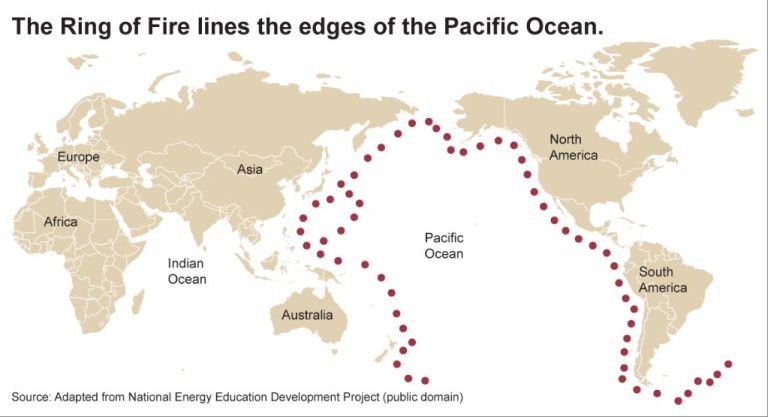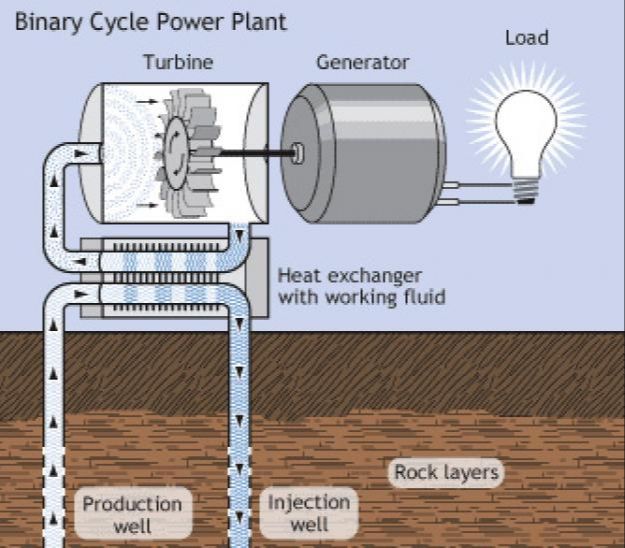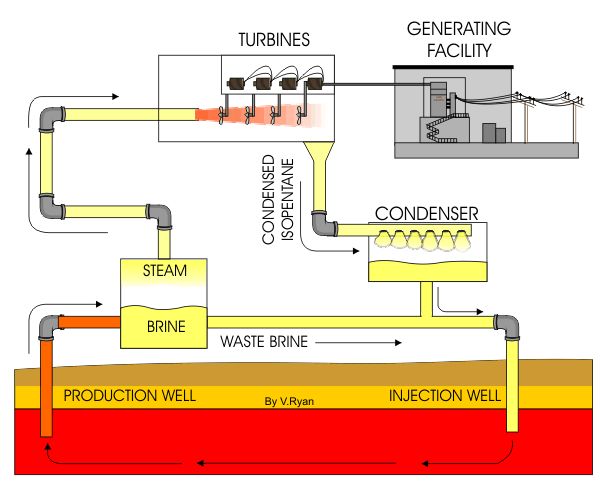How Deep Do You Need To Drill For Geothermal Energy?
Geothermal energy is heat derived from the earth. It comes from deep underground where the temperature is consistently hot. This heat can be captured and used to generate electricity, provide heating and cooling, or be used directly for processes that require heat (1). The high temperature results from the slow decay of radioactive particles, like uranium, thorium, and potassium, in the Earth’s core. This process happens in all rocks and produces geothermal energy (2).
Geothermal resources can be accessed by drilling wells into underground reservoirs for the generation of electricity or by using geothermal heat pumps to control building temperatures. Hot water near the earth’s surface can be piped directly into buildings for heat. Geothermal energy is considered renewable because the water is replenished by rainfall and the heat is continuously produced in the earth’s core (1).
Average Drilling Depths
The typical well depth for geothermal systems ranges from 300 feet to 10,000 feet, with most household geothermal systems requiring a well depth of 150-400 feet for adequate heat exchange (source). Drilling depths vary significantly depending on the type of geothermal system being utilized.
Shallow geothermal systems, used for direct heating applications like greenhouses, utilize much shallower wells typically less than 300 feet in depth. This allows them to tap into the constant shallow ground temperatures ideal for heating applications (source).
In contrast, deep geothermal wells over 1,500 feet are required for electric power generation. These wells tap into hotter resources deep underground where temperatures can exceed 150°C. The higher temperatures allow the geothermal fluid to produce steam to power electric generators at the surface (source).
The wide range of drilling depths for geothermal systems demonstrates the versatility of this technology to extract usable energy from the earth’s crust at various depths.
Factors Affecting Drilling Depth
There are several key factors that determine how deep wells need to be drilled for geothermal energy, including geology, type of geothermal system, temperature needed, and well type.
Geology plays a major role, as drilling depth depends on the subsurface temperature gradient and depth to hotter rocks. Areas with high heat flow and shallower hot aquifers and reservoirs require less deep wells. For example, the western U.S. has higher temperature gradients, reaching boiling point at 1-2 km depth, whereas the eastern U.S. requires 3-6 km depth to reach adequate temperatures.
The type of geothermal system also affects drilling depth. Shallow geothermal systems, utilizing ground source heat pumps for direct heating and cooling, only require wells 100-400 meters deep. Deep geothermal systems generating electricity from dry steam or hot water require much deeper wells from 1-3 km for hydrothermal reservoirs and 3-5 km for enhanced geothermal systems.
The temperature needed at depth determines drilling depth. For power generation, wells need to reach at least 150°C. For direct heating, 60-80°C is sufficient. The higher the temperature needed, the deeper wells must reach.
Finally, well type plays a role. Vertical wells are deeper, while horizontal wells can access reservoirs with less depth but greater drilling length. Most direct use wells are vertical, while deep wells for power tend to be deviated and horizontal.
Deep Wells
Deep geothermal wells typically reach depths of 3-10 kilometers or more below the Earth’s surface in order to tap into extremely high temperature resources. These wells are used for electricity generation via traditional hydrothermal resources as well as for Enhanced Geothermal Systems (EGS). EGS involves injecting fluid into hot dry rock reservoirs to extract heat through fractures in non-permeable rock (MIT, 2022).
At such extreme depths, temperatures can reach over 200°C which allows for the generation of renewable baseload power. The high temperatures also increase the efficiency of energy conversion. However, drilling to these depths poses engineering challenges and risks. Advanced technologies like millimeter wave drilling developed by companies like Quaise Energy are enabling deeper and more precise wells to be constructed (Quaise, 2022).
Overall, deep wells allow geothermal systems to tap into immense amounts of heat energy within the Earth’s crust for conversion into steady, renewable electricity generation.
Shallow Wells
Shallow geothermal wells typically range in depth from 1.5 to 400 meters below the surface. They utilize the constant temperatures in the upper crust of the Earth to provide heating and cooling for buildings and other applications. According to the European Geothermal Energy Council (EGEC), shallow geothermal energy is defined as geothermal energy utilized at depths of up to 400 meters. [1]
The moderate temperatures found at these shallower depths, usually between 10-20°C, can be used for heating and cooling using a geothermal heat pump system. These systems circulate a fluid through pipes buried underground to transfer heat between the Earth and buildings. During winter, the warmth of the Earth is absorbed by the fluid and used to heat indoor spaces. In summer, the process is reversed to provide cooling. Shallow geothermal systems are ideal for single family homes, schools, hospitals, factories, and commercial buildings.
Compared to deep geothermal systems, shallow wells are less expensive to drill and install. However, they can only provide lower temperature heat sources suitable for heating and cooling applications. The shallower depths also mean there is less heat available, so shallow geothermal is better suited for smaller scale uses.
Drilling Challenges
Geothermal drilling presents many technical challenges that contribute to high costs. According to a review paper, the most expensive problem routinely encountered is lost circulation, which is the loss of drilling fluid into fractures and pores in the rock. Controlling lost circulation requires advanced technologies like advanced drilling muds.
Drilling costs also rise exponentially with depth, requiring advanced drill bits and techniques. According to a 1982 report, each natural characteristic of geothermal resources causes difficulties for adapted petroleum drilling technology. The high temperatures and pressures, and hard, abrasive rock makes drilling challenging.
There are also uncertainties and risks inherent in geothermal drilling, like not finding a productive well or drilling into a dry hole. The technical difficulties and lack of guarantees mean geothermal projects require high upfront investments and carry financial risk.
Future Drilling Methods
New technologies are enabling more cost-effective and efficient geothermal drilling. Companies like Quaise Energy are utilizing automation and robotics to reduce labor costs and improve precision drilling. Their millimeter wave drilling system is adapted from nuclear fusion research and allows for more accurate and faster drilling [1].
Advanced materials like diamond-impregnated drill bits and downhole motors allow for increased durability and drill rates. Direction drilling techniques enable accessing geothermal reservoirs laterally, increasing the area that can be tapped from a single well. The US Department of Energy expects directional drilling to reduce geothermal costs by 25-50% [2].
Automation, advanced materials, and directional drilling will open up new geothermal resources and substantially lower the cost of geothermal energy in the coming years.
Environmental Impact
While geothermal energy has significantly lower emissions compared to fossil fuels, there are some environmental concerns to consider. One risk is induced seismicity from drilling and injecting fluid into wells. If not managed properly, this can trigger small earthquakes, like the ones caused by fracking operations (1). Land use is another consideration, as geothermal plants and wells take up a large surface area. However, the land in between can still be utilized for other purposes like agriculture. According to the U.S. Fish and Wildlife Service, geothermal results in substantially lower air emissions than fossil fuel plants. Sulfur dioxide and carbon dioxide emissions are reduced by up to 99% compared to coal plants (2). The EPA estimates geothermal power plants release less than 1% of the carbon dioxide emissions of comparable coal plants (3). While not completely risk-free, geothermal energy does offer major environmental benefits over conventional power sources.
(1) https://www.fws.gov/node/265252
(2) https://www.ucsusa.org/resources/environmental-impacts-geothermal-energy
(3) https://www.eia.gov/energyexplained/geothermal/geothermal-energy-and-the-environment.php
Cost Analysis
Drilling wells for geothermal energy can be quite expensive, especially for deep wells. According to HowStuffWorks, drilling a 2.5-mile (4 km) well costs around $5 million [1]. Wells reaching 6.2 miles (10 km) deep can cost even more. The depth required depends on the geothermal resource available.
In terms of cost per kilowatt (kW) installed, geothermal is competitive with other energy sources. According to Statista, between 2010-2022 the global average installed cost per kW for geothermal ranged from $2,700 to $5,600 [2]. This is comparable to solar photovoltaics ($1000-4000 per kW), onshore wind ($1400-4000 per kW), and offshore wind ($4000-6500 per kW).
While drilling accounts for a significant portion of geothermal project costs, the ability to provide reliable baseload renewable energy makes it an attractive option. With advances in drilling technology, costs are expected to decrease further in the future.
Conclusions
In summary, geothermal drilling depths can vary greatly depending on the type of geothermal system and location. Shallow wells for direct use applications are typically less than 400 feet deep, while deep wells for electrical power generation can reach depths of 1-2 miles or more.
The most advanced enhanced geothermal systems are targeting depths of 3-10 miles in the future, where temperatures are highest. Companies like Quaise Energy are pioneering new drilling techniques to make deep geothermal more viable.
While deep drilling presents engineering challenges, the enormous renewable energy potential makes it worth pursuing. With continued technology improvements, deep geothermal could provide a substantial portion of the world’s electricity needs in a clean, renewable manner.




